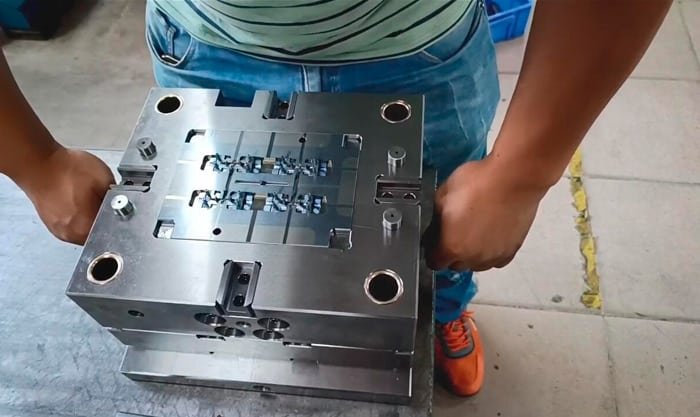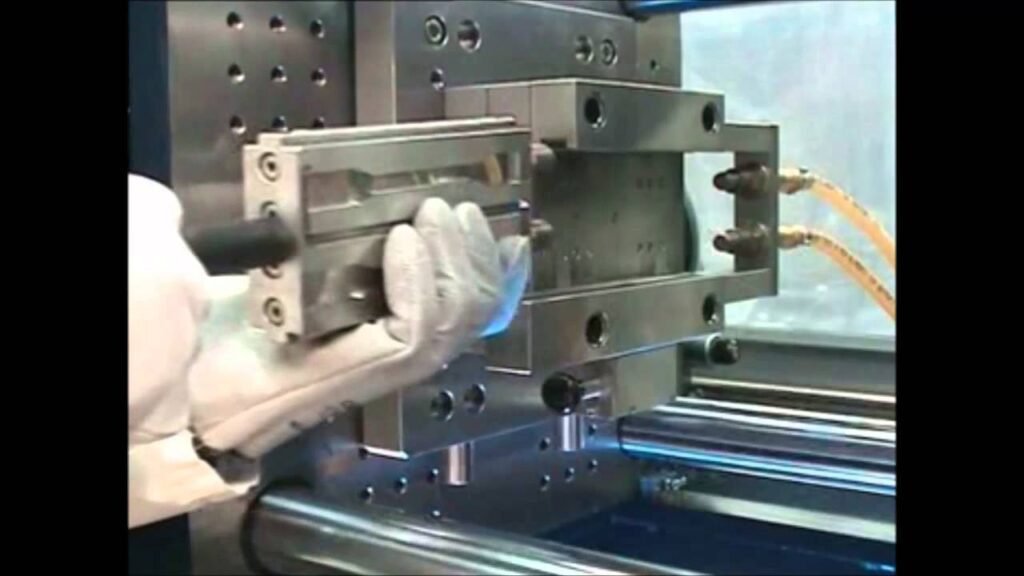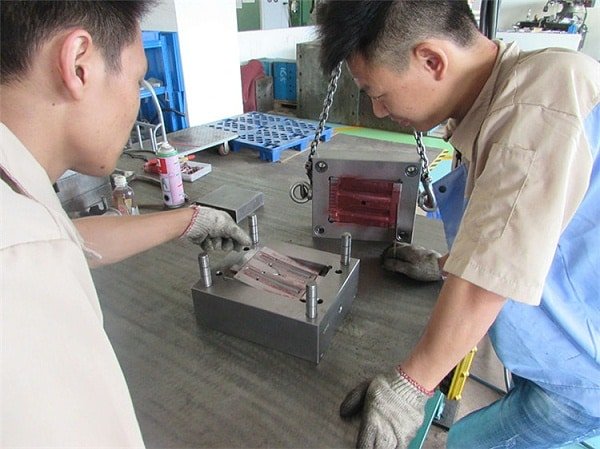Test Items Of Injection Mould
1. Learn about the relevant information of the mold:
It is best to obtain the design drawings of the mold, analyze them in detail, and arrange for mold technicians to participate in the mold testing process.
2. Check the mechanical coordination action on the workbench first:
Be aware of any scratches, missing parts, and looseness, and ensure that the mold slides are moving properly. Check for leaks in the water and air lines, and indicate any restrictions on the mold travel on the mold. By taking these steps before hanging the mold, you can avoid any issues that may arise during the process and avoid wasting time disassembling the mold if problems are discovered.

3. After determining the proper actions of each part of the mold, it is necessary to choose a suitable mold testing injection machine. When selecting, attention should be paid to:
Injection Capacity
Width of the guide rod
The maximum stroke
Whether the accessories are complete, etc. After confirming that everything is okay, the next step is to suspend the mold. When hanging, it should be noted that the suspension hook should not be removed until all the clamping templates are locked and the mold is opened, so as to avoid loosening or breaking the clamping templates and causing the mold to fall.
After the mold is installed, carefully check the mechanical actions of each part of the mold, such as the action of the slide plate, the ejector pin, the backlash structure, and the limit switch. Pay attention to whether the injection nozzle and the feed port are aligned. The next step is to pay attention to the mold closing action. At this time, lower the mold closing pressure, and during manual and low-speed mold closing actions, pay attention to seeing and listening for any unsmooth actions and abnormal sounds.

4. Increase the mold temperature:
Select the appropriate mold temperature controller based on the properties of the raw materials used in the finished product and the size of the mold to increase the temperature of the mold to the required temperature for production. After the mold temperature is increased, it is necessary to re-inspect the actions of each part, as thermal expansion of steel may cause die sticking, so attention should be paid to the sliding of each part to avoid strain and vibration.
If the factory does not implement the experimental plan rule, we recommend adjusting only one condition at a time when adjusting the mold testing conditions, in order to distinguish the impact of a single condition change on the finished product.
6. Depending on the raw materials, the raw materials used should be moderately baked.
7. Try to use the same raw materials for the mold trial and future mass production.
8. Do not completely test the mold with inferior materials. If there is a color requirement, arrange a color test at the same time.
9. Internal stress and other issues often affect secondary processing. After testing the mold and stabilizing the finished product, perform secondary processing. After closing the mold slowly, adjust the mold closing pressure and move it several times to check for uneven mold closing pressure, so as to avoid burrs on the finished product and mold deformation.
After checking the above steps, lower the mold closing speed and pressure, set the safety latch rod and top travel, and then adjust the normal mold closing and mold closing speed. If the limit switch involves the maximum travel, adjust the mold opening stroke slightly shorter, and cut off the high-speed mold opening action before this maximum mold opening stroke.
This is because during the entire mold opening stroke during mold assembly, the high-speed motion stroke is longer than the low-speed one. The mechanical ejection rod on the plastic machine must also be adjusted to operate after the full-speed mold opening action, to prevent deformation of the ejector plate or stripping plate due to stress.
Please check the following items before making the first injection:
Whether the feeding stroke is too long or insufficient.
Whether the pressure is too high or too low.
Whether the filling speed is too fast or too slow.
Whether the processing cycle is too long or too short.
to prevent short shots, breakage, deformation, burrs, and even damage to the mold.
If the processing cycle is too short, the thimble will break through the finished product or squeeze the finished product by stripping the ring. Such situations may require you to spend two to three hours to remove the finished product.
If the processing cycle is too long, the weak parts of the mold may break due to the shrinkage of the rubber compound.
Of course, you cannot predict all the possible problems that may occur during the trial process, but careful consideration and timely measures in advance will help you avoid serious and costly losses.

Main steps of mold testing:
To avoid unnecessary waste of time and trouble during mass production, it is necessary to be patient in adjusting and controlling various processing conditions, finding the best temperature and pressure conditions, and developing standard molding procedures that can be used to establish daily work methods.
1. Check whether the plastic material in the barrel is correct and whether it has been baked according to regulations (different materials used for trial molding and production may result in different results).
2. The cleaning of the material tube should be thorough to prevent inferior glue or impurities from entering the mold, as inferior glue and impurities may cause the mold to jam. Test the temperature of the material tube and mold to ensure that they are suitable for processing the raw materials.
Adjust the pressure and injection volume to produce a finished product with a satisfactory appearance, but be sure not to introduce burrs, especially when some of the mold cavities have not fully solidified. Before adjusting various control conditions, it is important to consider that even slight changes in the filling rate can cause significant changes in the filling process.
4. Be patient and wait until the conditions of the machine and mold have stabilized, which may take more than 30 minutes for a medium-sized machine. Use this time to review possible problems with the finished product.
The screw advancing time should not be shorter than the plastic solidification time of the gate, otherwise the weight of the finished product will decrease and the performance of the finished product will be compromised. When the mold is heated, the screw advancing time also needs to be extended appropriately to compact the finished product.
6. Reasonably adjust and reduce the total processing cycle.
7. Run the newly adjusted conditions for at least 30 minutes until they are stable, and then produce at least a dozen full-size samples continuously. Mark the date and quantity on their containers, and place them according to the mold cavities to test their stability and derive reasonable control tolerances. (This is especially valuable for multi-cavity molds).
Measure and record the important dimensions of the continuous sample (measure it after the sample has cooled to room temperature).
9. Compare the measured dimensions of each sample, and pay attention to:
Whether the size is stable.
Are there any trends in the increase or decrease of certain dimensions that indicate that the machine processing conditions are still changing, such as poor temperature control or oil pressure control.
Whether the change in size is within the tolerance range.
10. If the size of the finished product does not change much and the processing conditions are normal, it is necessary to observe whether the quality of the finished product of each the first mock examination cavity is acceptable and its size can be within the allowable tolerance. Record the number of mold cavities that are measured continuously, or are larger or smaller than the average value, in order to check if the size of the mold is correct.
Record and analyze data as necessary for modifying molds and production conditions, and as a reference for future mass production.
1. Make the processing operation longer to stabilize the melt temperature and hydraulic oil temperature.
2. Adjust the machine conditions based on the oversize or undersize of all finished products. If the shrinkage rate is too large and the finished product appears to be underfilled, it may also be helpful to increase the gate size as a reference.
Correct the size of each mold cavity if it is too large or too small. If the mold cavity and door size are still correct, then try to modify the machine conditions, such as the filling rate, mold temperature, and pressure of each part, and check whether some mold cavities fill slower.
4. Make individual corrections based on the coordination of the finished products in each mold cavity or mold core displacement. It may be possible to re-adjust the filling rate and mold temperature to improve uniformity.
Check and correct the faults of the injection machine, such as poor performance of the oil pump, oil valve, temperature controller, etc., which can cause changes in processing conditions. Even the most well-designed mold cannot achieve good work efficiency on poorly maintained machinery.
After reviewing all recorded values, retain a set of samples for comparison to verify whether the corrected samples have improved.
Important Matters
Properly maintain all records of sample inspection during the mold testing process, including various pressures during the processing cycle, melt temperature and mold temperature, material tube temperature, injection action time, screw feeding period, etc. In short, all data that will help to establish the same processing conditions in the future should be maintained in order to obtain products that meet quality standards.
Currently, mold temperature is often neglected during factory trial molding, and it is the most difficult to control during short-term trial molding and future mass production. Incorrect mold temperature can affect the dimensions, luminosity, shrinkage, flow pattern, and underfill of the sample, and without using a mold temperature controller, difficulties may arise during future mass production.
